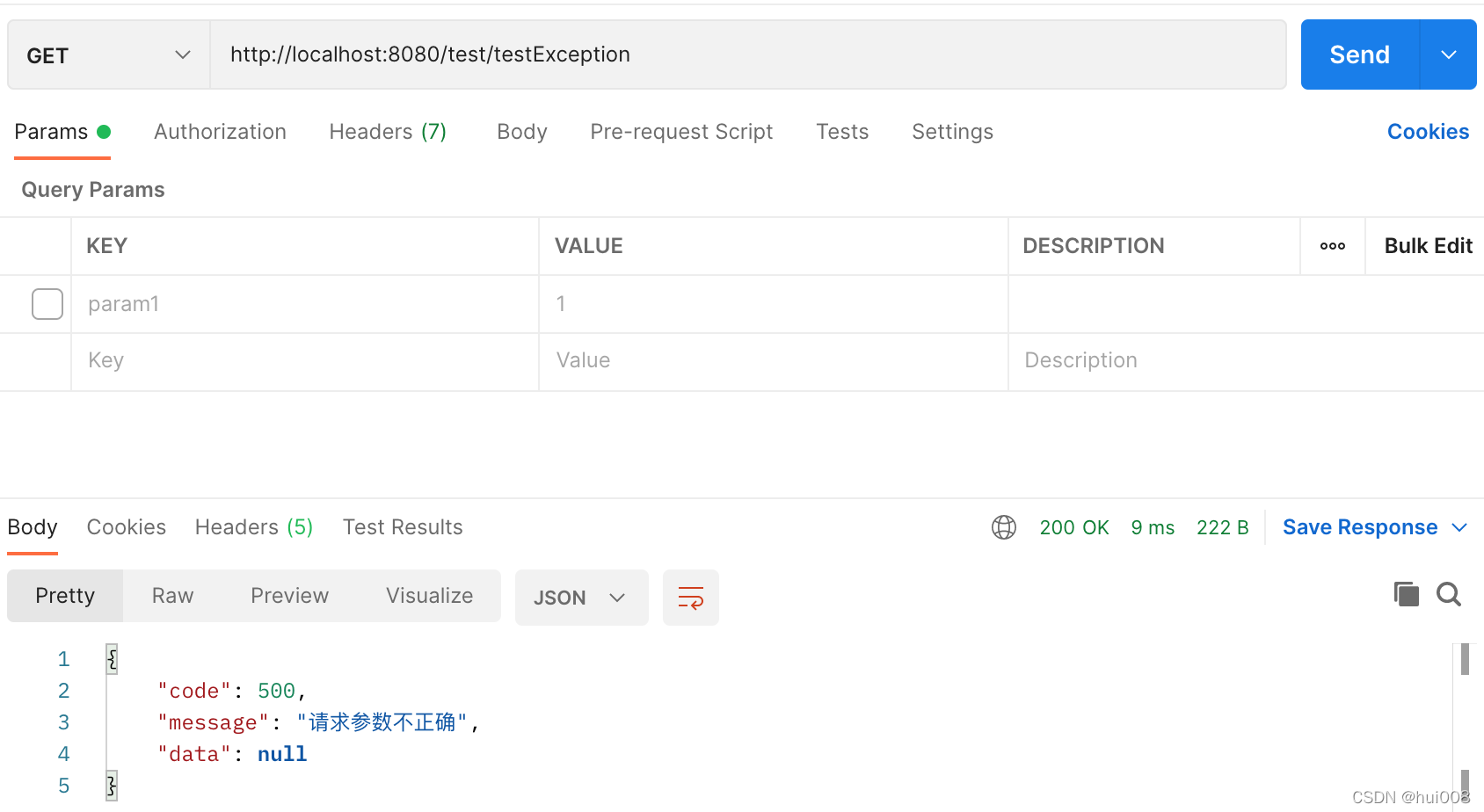1、准备工作
1.1 定义返回状态码,通常无异常返回200,业务异常返回500
package com.hwh.constant;
/**
* 返回状态码
*
* @author heweihui
*/
public class HttpStatus {
/**
* 操作成功
*/
public static final int SUCCESS = 200;
/**
* 对象创建成功
*/
public static final int CREATED = 201;
/**
* 请求已经被接受
*/
public static final int ACCEPTED = 202;
/**
* 操作已经执行成功,但是没有返回数据
*/
public static final int NO_CONTENT = 204;
/**
* 资源已被移除
*/
public static final int MOVED_PERM = 301;
/**
* 重定向
*/
public static final int SEE_OTHER = 303;
/**
* 资源没有被修改
*/
public static final int NOT_MODIFIED = 304;
/**
* 参数列表错误(缺少,格式不匹配)
*/
public static final int BAD_REQUEST = 400;
/**
* 未授权
*/
public static final int UNAUTHORIZED = 401;
/**
* 访问受限,授权过期
*/
public static final int FORBIDDEN = 403;
/**
* 资源,服务未找到
*/
public static final int NOT_FOUND = 404;
/**
* 不允许的http方法
*/
public static final int BAD_METHOD = 405;
/**
* 资源冲突,或者资源被锁
*/
public static final int CONFLICT = 409;
/**
* 不支持的数据,媒体类型
*/
public static final int UNSUPPORTED_TYPE = 415;
/**
* 系统内部错误
*/
public static final int ERROR = 500;
/**
* 接口未实现
*/
public static final int NOT_IMPLEMENTED = 501;
}
1.2 定义业务异常ServiceException继承RuntimeException
package com.hwh.exception;
/**
* 业务异常类
*
* @author heweihui
*/
public class ServiceException extends RuntimeException{
private static final long serialVersionUID = -999820107846632460L;
/**
* 错误码
*/
private Integer code;
/**
* 错误提示
*/
private String message;
public Integer getCode() {
return code;
}
public void setCode(Integer code) {
this.code = code;
}
@Override
public String getMessage() {
return message;
}
public void setMessage(String message) {
this.message = message;
}
public ServiceException() {
}
public ServiceException(String message) {
this.message = message;
}
public ServiceException(Integer code, String message) {
this.code = code;
this.message = message;
}
}
1.3 定义返回结果类ResponseResult
package com.hwh.entity;
import com.hwh.constant.HttpStatus;
import lombok.AllArgsConstructor;
import lombok.Data;
import lombok.NoArgsConstructor;
@Data
@NoArgsConstructor
@AllArgsConstructor
public class ResponseResult {
private int code;
private String message;
private Object data;
public static ResponseResult success(){
return success("success");
}
public static ResponseResult success(String message){
return success(message, null);
}
public static ResponseResult success(Object data){
return success(null, data);
}
public static ResponseResult success(String message, Object data){
return new ResponseResult(HttpStatus.SUCCESS, message, data);
}
public static ResponseResult error(){
return error("error");
}
public static ResponseResult error(String message){
return error(message, null);
}
public static ResponseResult error(String message, Object data){
return new ResponseResult(HttpStatus.ERROR, message, data);
}
public static ResponseResult error(int code, String message){
return new ResponseResult(code, message, null);
}
}1.4 定义全局异常处理器GlobalExceptionHandler
package com.hwh.advice;
import com.hwh.entity.ResponseResult;
import com.hwh.exception.ServiceException;
import lombok.extern.slf4j.Slf4j;
import org.springframework.util.StringUtils;
import org.springframework.web.bind.annotation.ExceptionHandler;
import org.springframework.web.bind.annotation.RestControllerAdvice;
import javax.servlet.http.HttpServletRequest;
/**
* 全局异常处理器
*
* @author heweihui
*/
@Slf4j
@RestControllerAdvice
public class GlobalExceptionHandler {
/**
* 业务异常
*/
@ExceptionHandler(ServiceException.class)
public ResponseResult handleServiceException(ServiceException e, HttpServletRequest request)
{
log.error(e.getMessage(), e);
Integer code = e.getCode();
return code == null ? ResponseResult.error(code, e.getMessage()) : ResponseResult.error(e.getMessage());
}
/**
* 拦截未知的运行时异常
*/
@ExceptionHandler(RuntimeException.class)
public ResponseResult handleRuntimeException(RuntimeException e, HttpServletRequest request)
{
String requestURI = request.getRequestURI();
log.error("请求地址'{}',发生未知异常.", requestURI, e);
return ResponseResult.error(e.getMessage());
}
/**
* 系统异常
*/
@ExceptionHandler(Exception.class)
public ResponseResult handleException(Exception e, HttpServletRequest request)
{
String requestURI = request.getRequestURI();
log.error("请求地址'{}',发生系统异常.", requestURI, e);
return ResponseResult.error(e.getMessage());
}
}
1.5 定义ErrorCode枚举类,存储业务异常编码跟异常信息
package com.hwh.error;
public enum ErrorCode {
REQUEST_PARAM_ERROR(1001, "请求参数不正确");
private int code;
private String message;
ErrorCode(int code, String message) {
this.code = code;
this.message = message;
}
public int getCode() {
return code;
}
public String getMessage() {
return message;
}
}
2、准备工作就绪,下面编写service类进行测试
2.1 定义TestService类,模拟一个业务异常跟一个未知异常
package com.hwh.service;
import com.hwh.error.ErrorCode;
import com.hwh.exception.ServiceException;
import org.springframework.stereotype.Service;
import org.springframework.util.StringUtils;
/**
*
* @author heweihui
*/
@Service
public class TestService {
public void TestException(String param){
//业务异常
if(StringUtils.isEmpty(param)){
throw new ServiceException(ErrorCode.REQUEST_PARAM_ERROR.getCode(),
ErrorCode.REQUEST_PARAM_ERROR.getMessage());
}
//未知异常
int i = 1 / 0;
System.out.println(i);
}
}
2.2 变成测试controller进行测试
@GetMapping("testException")
public void testException(@RequestParam(value = "param1", required = false) String param1){
testService.TestException(param1);
}3、postman测试
3.1 不传递参数param1

3.2 正常传递参数param1

下篇在此基础上写基于Validation进行参数校验封装,继续加油吧!
版权声明:本文为hui008原创文章,遵循CC 4.0 BY-SA版权协议,转载请附上原文出处链接和本声明。